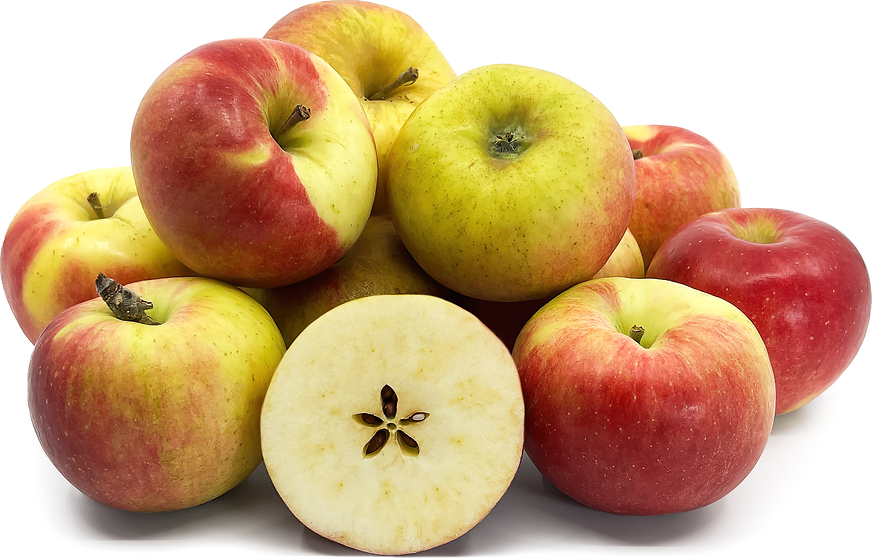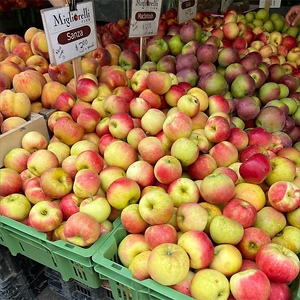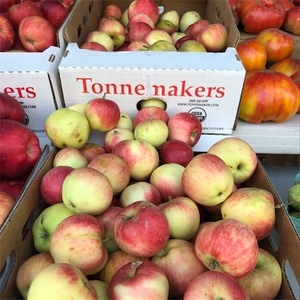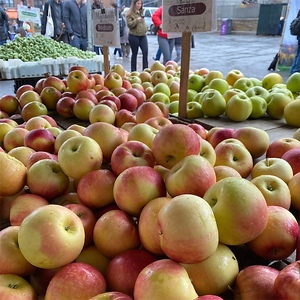


Sansa Apples
Estimated Inventory, lb : 0
Description/Taste
Sansa apples are moderately sized, conical to round fruits with light ribbing. The skin is smooth, waxy, firm, and has a yellow-green base, covered in dark red-orange striping and blush. Underneath the surface, the cream-colored flesh is crisp, aqueous, coarse, and aromatic when sliced, encasing a central core filled with small, black-brown seeds. Sansa apples are crunchy and have a balanced, sweet-tart flavor with notes of grapefruit, cane sugar, and acidity.
Seasons/Availability
Sansa apples are available late summer through fall.
Current Facts
Sansa apples, botanically classified as Malus domestica, are an early season variety that belongs to the Rosaceae family. The Japanese hybrid is a cross between gala and akane apples and is considered to be one of the first sweet apples to ripen each season. Sansa apples were selected as an improved gala variety with high yields and resistance to disease. The sweet-tart fruits are not commercially cultivated due to their short shelf life and are primarily grown as a companion plant in orchards, providing farmers with an early variety to sell before the main crop season begins.
Nutritional Value
Sansa apples are a good source of potassium, which is a mineral that balances fluid levels, and contain fiber, which can help regulate digestion. The fruits also provide some calcium, phosphorus, and vitamin C.
Applications
Sansa apples are best suited for raw applications as their balanced, sweet-tart flavor is showcased when consumed fresh, out-of-hand. The apples can be sliced and served with nut butter, dips, and cheeses, chopped and tossed into green and fruit salads, layered into sandwiches and burgers for added crunch, or dipped in icing or caramel for a sweet dessert. Sansa apples can also be blended into applesauce, lightly baked into bread, muffins, and tarts, or thinly sliced and dried for extended use. Sansa apples pair well with zucchini, nuts such as almonds, hazelnuts, and pistachios, cranberries, persimmons, spices such as cinnamon, clove, and nutmeg, vanilla, and honey. It is important to note that Sansa apples have a short shelf life and will only keep 1-2 weeks when stored in a cool, dry, and dark place such as the refrigerator.
Ethnic/Cultural Info
In New Zealand, Sansa apples are featured as one of the apple varieties used to make ciders at the New Zealand Cider Festival. This annual event celebrates the growing cider industry in the city of Nelson and is held at Founders Heritage Park, hosting two days of tastings, educational talks, and live entertainment. The festival also promotes the zero-waste movement and utilizes reusable containers for their cider tastings. Ciders in New Zealand are growing in popularity, and many of the local cideries are using unique apple varieties to develop their craft beverages. Sansa apples are commonly incorporated into contemporary ciders and are married with other dessert and heritage varieties to create a balanced, sweet and tangy flavor.
Geography/History
Sansa apples were developed from a partnership between researchers based in Japan and New Zealand. In 1969, pollen from the Japanese akane apple was first sent to New Zealand, where Dr. Don McKenzie cross-pollinated the variety with gala apples. Once the experiment was complete, the resulting seeds were sent back to Japan to Dr. Yoshio Yoshida at the Morioka Research Station. Dr. Yoshida continued to cultivate the variety for almost twenty years before releasing it to market in 1988. Today Sansa apples are available through local markets and online seed catalogs for home garden use in New Zealand, Japan, and in the United States.
Recipe Ideas
Recipes that include Sansa Apples. One
| Dinner at the Zoo |
|
Brussels Sprout Salad |












